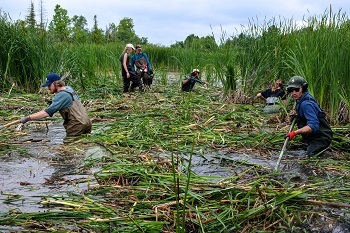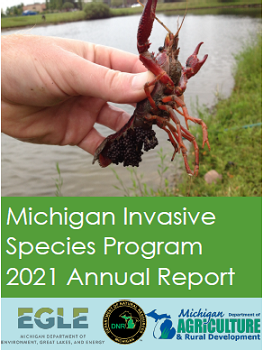|
March 1, 2022
Contact: Joanne Foreman, 517-284-5814
The state of Michigan today announced that 31 projects will share $3.6 million in grants through the Michigan Invasive Species Grant Program.

The program – cooperatively implemented by the Michigan departments of Agriculture and Rural Development; Environment, Great Lakes, and Energy; and Natural Resources – addresses prevention, detection, eradication and control of aquatic (water-based) and terrestrial (land-based) invasive species in Michigan through four key objectives:
- Preventing the introduction of new invasive species.
- Strengthening the statewide invasive species early detection and response network.
- Limiting the spread of recently confirmed invasive species.
- Managing and controlling widespread, established invasive species.
This year’s grantees have offered $541,500 in matching funds and services to support these projects, leveraging a total investment of $4,141,500.
|
Improving prevention and management
This year’s grants will provide funding for a range of efforts targeting aquatic invasive species:
- Continuing Michigan’s RIPPLE (Reduce Invasive Pet and PLant Escapes) program to prevent introductions of aquarium and water garden pets and plants to Michigan waters.
- Incorporating the retired DNR research vessel Chinook as an exhibit for education on Great Lakes aquatic invasive species issues at the Besser Museum in Alpena.
- Limiting the spread of aquatic invasive species by engaging watercraft inspectors and purchasing and deploying two boat-wash units at boating access sites across Schoolcraft and Delta counties in the Upper Peninsula.
- Developing an effective, systematic surveying design for European frog-bit that can be used to guide surveying for similar species of concern.
- Increasing recreational boaters’ adoption of “Clean, Drain, Dry” practices by leveraging boating industry partnerships in a statewide messaging campaign.
Funding also will support projects to prevent and manage terrestrial invasive species:
- Piloting an invasive species education and prevention program for off-road vehicle enthusiasts in northern Michigan.
- Increasing releases of the leaf-feeding moth Hypena opulenta in Lower Michigan for biological control of invasive swallow-wort vines.
- Testing airborne environmental DNA to detect hemlock woolly adelgid to aid in detection of new populations and evaluate current treatment measures.
Support in every Michigan county

This year’s grants also will support 21 regional cooperative invasive species management areas, the network of partnership organizations working to manage and control invasive species and provide service to all 83 counties in the state. CISMA projects include enhanced education and outreach, technical assistance to landowners, and survey and treatment of high-priority invasive species.
|
Program background and progress
In 2014 the state Legislature designated $5 million in annual funding to address invasive species. This support substantially enhanced Michigan’s Invasive Species Program for aquatic organisms, supported a formal program for terrestrial species and initiated the Michigan Invasive Species Grant Program.

This cycle marks the eighth year of program funding. To date, over $29 million has been awarded to support 202 projects undertaken by units of government, nonprofits and institutions. Because of this program:
- More than 548,000 acres of land and water have been surveyed for invasive species.
- More than 44,000 acres have been treated for invasive terrestrial and aquatic plants.
- Through direct contact, including face-to-face interactions at boat washes, workshops, trainings and other events, 257,000 people have been reached with information about invasive species.
- An additional 35 million people were reached through grantees’ “passive impression” efforts, including mail, newspapers, social media and handouts.
|
Highlights of the 2021 program are available in the Michigan Invasive Species Program Annual Report, which includes program-funded projects.
Nearly $6 million requested
The program began accepting grant applications for this funding cycle in September 2021. A total of 43 applications were received, requesting approximately $5.8 million in support. Grant applicants were asked to commit to providing at least 10% of the total project cost in the form of a local match.
The full list of grant recipients, project descriptions and award amounts is available on the Michigan Invasive Species Grant Program website at Michigan.gov/MISGP.
Michigan's Invasive Species Program is cooperatively implemented by the Michigan departments of Agriculture and Rural Development; Environment, Great Lakes and Energy; and Natural Resources.
/Note to editors: Accompanying photos are available below for download. Suggested captions and photo credit information follow:
Wash: A portable boat wash operating at Lake Ovid in Clinton County. Photo courtesy of EGLE.
Cattails: Volunteers assist in removing invasive cattails and European frog-bit from the Duck Park shoreline in Alpena. Photo courtesy of Chris Engle, Huron Pines./
|